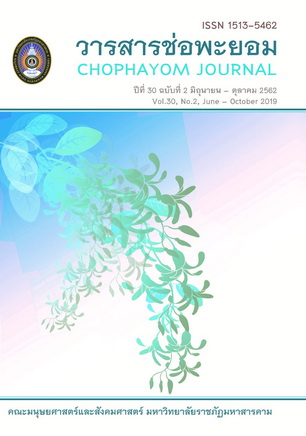A Causal Relationship Model Of Stress Management Behavior Among Students At Sirindhorn College Of Public Health, Chonburi
Keywords:
Stress management, Theory of plan behaviorAbstract
The purpose of this research was to develop a causal relationship model of stress management behavior among students at Sirindhorn College of public health, Chonburi. The sample, derived by means of stratified random sampling, consisted of 400 students who studied in the 1st- 4th years in 2018. The research instruments were questionnaires. Causal model analysis involved the use of path analysis. Results indicated that the model of stress management behavior among students at Sirindhorn College of public health, Chonburi was consistent with empirical data. Modal validation of good fitted model provided Chi-Square test of goodness of fit = 54.70, p = 0.21, GFI = 0.98, AGFI = 0.96, CFI = 1.00, NNFI = 0.99, NFI = 0.99, SRMR = 0.03 and RMSEA = 0.02. All independent variables in the model were accounted for 76% of the variance of stress management behavior. Behavioral intention, perceived behavior control on stress management had direct effect on practice to stress management behavior were 0.74 and 0.21 respectively. Subjective norm,
perceived behavior control on stress management and attitude toward stress management behavior had indirect effect on practice to stress management behavior were 0.30, 0.29 and 0.16 respectively.
Keywords : Stress management, Theory of plan behavior
References
จิรกุล ครบสอน และนุจรี ไชยมงคล. (2556, เมษายน-มิถุนายน). ความเครียดและพฤติกรรมการเผชิญความเครียดของวัยรุ่นในสถานพินิจและคุ้มครองเด็กและเยาวชน. วารสารคณะพยาบาลศาสตร์ มหาวิทยาลัยบูรพา, 21(2), 1-12.
จุฑารัตน์ สถิรปัญญา และวิทยา เหมพันธ์. (2556, มกราคม-มิถุนายน). ความเครียดของนักศึกษามหาวิทยาลัย. วารสารศิลปะศาสตร์ มหาวิทยาลัยแม่โจ้, 1(1), 42-58.
ปฐมพร โพธิ์ถาวร, อำไพอร เพ็ญสุวรรณ และสาวิตรี วงค์ประดิษฐ์. (2557, พฤษภาคม-สิงหาคม). การฝึกปฏิบัติสมาธิด้วยการหายใจ และระดับความเครียดของนักศึกษาพยาบาลที่ฝึกปฏิบัติงานในห้องคลอด. วารสารเครือข่ายวิทยาลัยพยาบาลและการสาธารณสุขภาคใต้, 1(2), 49-59.
ปิยรัตน์ จิตรภักดี, นงนุช นามวงษ์, ทัศนันท์ ทุมมานนท์, กรรณิการ์ กุลเกียรติชัย และดำรงศักดิ์ สอนแจ้ง. (2560, กันยายน-ธันวาคม). ความเครียดของนักศึกษาวิทยาลัยการสาธารณสุขสิรินธร จังหวัดชลบุรี. วารสารโรงพยาบาลชลบุรี, 42(3), 229-236.
มาโนช หล่อตระกูล และปราโมทย์ สุคนิชย์. (2558). จิตเวชศาสตร์ รามาธิบดี. กรุงเทพฯ: ภาควิชาจิตเวชศาสตร์ คณะแพทยศาสตร์โรงพยาบาลรามาธิบดี มหาวิทยาลัยมหิดล.
วิทยาลัยการสาธารณสุขสิรินธร จังหวัดชลบุรี. (2561). สถิตินักศึกษาวิทยาลัยการสาธารณสุขสิรินธร จังหวัดชลบุรี ประจำปีการศึกษา 2561. ชลบุรี: วิทยาลัยการสาธารณสุขสิรินธร จังหวัดชลบุรี.
ศริญญา จริงมาก. (2561, มกราคม-มีนาคม). ความเครียด และวิธีการจัดการความเครียดของนักศึกษาชั้นปีที่ 1 มหาวิทยาลัยราชภัฏอุดรธานี. วารสารการพัฒนาสุขภาพชุมชน มหาวิทยาลัยขอนแก่น, 6(1), 43-58.
สินีนาฏ โคตรบรรเทา, สินีนาฏ วิทยพิเชฐสกุล, อนุช แซ่เล้า และพูลพงศ์ สุขสว่าง. (2557, กรกฎาคม-ธันวาคม). โมเดลความสัมพันธ์เชิงสาเหตุของการปฏิบัติตนเพื่อลดความเสี่ยงต่อการเกิดโรคความดันโลหิตสูงของประชาชนเทศบาลเมืองบ้านสวน อำเภอเมือง จังหวัดชลบุรี. วารสารสาธารณสุขมหาวิทยาลัยบูรพา, 9(2), 85-96.
Ajzen, I. (2012). The theory of planned behavior. In P. A. M. Lange, A. W. Kruglanski, & E. T. Higgins (Eds.). Handbook of theories of social psychology. London: Sage.
Goldberg, J. (2014). Cause of stress. Retrieved 12 February 2019. from https://www.webmd.com/ balance/guide/causes-of-stress.
Lazuras, L., Chatzipolychroni, E., Rodafinos, A., & Eiser, J. R. (2012, March). Social cognitive predictors of smoking cessation intentions among smoker employees: The roles of anticipated regret and social norms. Addictive Behaviors, 37, 339-341.
McConnon, A., Raats, M., Astrup, A., Bajzova, M., Handjieva-Darlenska, T., Lindroos, A. K., Martinez, J. A., Larson, T. M., Papadaki, A., Pfeiffer, A., van Baak, M. A., & Shepherd, R. (2012, February). Application of the theory of planned behaviour to weight control in an overweight cohort. Results from a pan-European dietary intervention trial (DiOGenes). Appetite, 58, 313-318.
Moss, R. H., & Billings, A. G. (1982). Conceptualizing and measuring coping resources and processes. In L. Goldberger & S. Breznitz (Eds.), Handbook of stress: Theoretical and clinical aspects. New York, NY: Free Press.
Schumacker, R. E., & Lomax, R. G. (2010). A Beginner’s Guide to Structural Equation Modeling (3rd ed.). New York: Taylor & Francis Group.






